The Depression in West Durham
By Billy B. Olive
One cannot write about the period of 1928 to 1934 without relating this period to the very drastic financial strain placed on most families. I will thus recite just a few memories of what it meant to live in old West Durham during the Depression. Finding housing at a price that could be afforded was a challenge for my father particularly. To save expenses, we had to share our house with my mother's sister's family.
As my father sought cheaper rents, I remember the tears when both families had to move from a nice location on Englewood Avenue, which my parents owned, to three successive rented locations in old West Durham (including a house on Ninth Street). The fact that this same experience befell many others helped soften the blow for my parents. However, as part of a large family, there was much excitement when we moved to a new house. As I look back, I can see that character was being molded.

Early neighborhoods in the West Durham area (courtesy of Caleb Southern).
Click on map to see better image.
Flour bags & shoes
The Depression affected our family in many other ways. My mother made and fed the family many biscuits and for this we found it economical to buy flour by the bag at two small neighborhood stores on either side of Hillsborough Road (near where Strawbridge Studios are today).
Choosing the particular bag of flour to be purchased became a matter of choosing the particular brand of flour which was bagged in the most attractive print suitable for conversion to some kind of garment. All the manufacturers of flour soon learned that their customers were using flour bags as an important source of cloth for making items such as underwear, towels, shirts, handkerchiefs and the like and our family, by necessity, became part of this cycle.
Shoe soles were expensive to buy when shoes needed to be repaired and while stick-on shoe soles were available in the "5 and 10" cent store for perhaps 10 cents, such amount was not always available when a hole appeared in a shoe. Thus, a common expedient at the start of each day when shoes could not be repaired was to cut out a piece of cardboard to fit the inside of the shoe as a temporary sole and which would usually last for a day. As I look back, I can see that I was being taught some basic lessons in economics.
Dog days of summer
A cheap way to a void the expense of the City building a swimming pool for use during the hot summer days involved the local firemen. Thus, a common practice of firemen to the delight of children in West Durham was to connect a fire hose to a fire hydrant on Alabama Avenue, attach a fire nozzle to the hose and elevate the nozzle so that children could dash in and out of water sprayed from the nozzle. Such experiences undoubtedly built up respect for the firemen in the minds of the children.
While not related to the Depression, there were many other interesting experiences in old West Durham that delighted the children. One such experience involved the iceman who would deliver blocks of ice to be stored in people's ice boxes as a source of cooling. The iceman who was the greatest favorite among the children was the iceman who knew how to skillfully use his ice pick on a hot summer day so that every child got a least one chip of ice on which to suck.

Seven ice trucks (ca. 1930): The Durham Public Service Company not only furnished ice but also operated Durham's transportation and and electrical systems. The Duke Power Co. later took over the electrical and transportation facilities. Public Service Co. of N.C. is the name now used by the distributor of natural gas.
Disease in the community
Another memory relates to how infectious diseases were publicized in the West Durham community. When anyone in a family came down with any one of several diseases such as influenza, measles, chicken pox or mumps, a sign of a particular color would be tacked onto the front of the house with a warning to all visitors.
Needless to say, the removal of such a sign was always an event to be welcomed particularly in a large family since one child's sickness affected all members of the family and its hardship had to be shared.
West Durham Airport
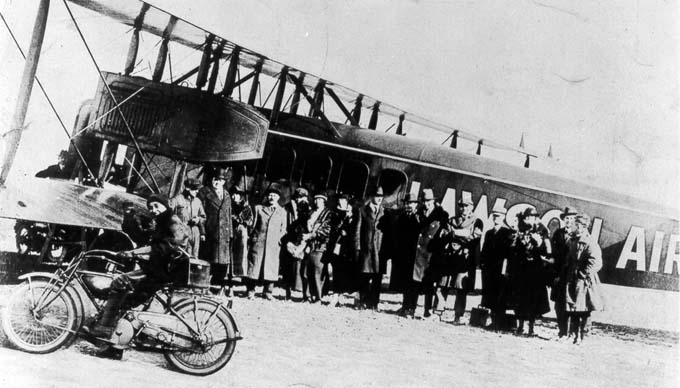
Group of warmly-dressed men and women pose at side of biplane preparing
for takeoff (Durham, ca. 1920).
Another event which I relate to West Durham concerns my first flight in an airplane which took place at what was then called the West Durham Airport and whose counterpart was the then existing East Durham Airport. The beginning of the runway for the West Durham Airport began just west of the intersection of the present Albany and Sovereign Streets and went downhill generally towards Alabama Avenue and over much of what is now the Hillandale Golf Course.
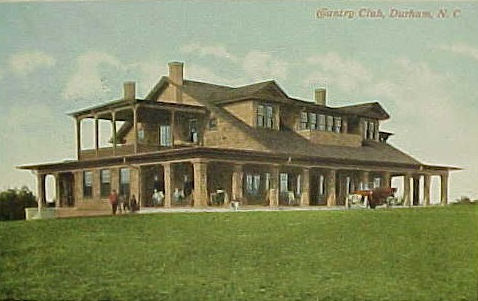
The old clubhouse, near the corner of Hillandale and Club Blvd (once
called E Street).
On this particular day, a friend and myself somehow got up our "nerve" and the necessary $10 charge and we found ourselves seated side by side in a Ford Trimotor aircraft. With a roar, we went bumping down the dirt runway and took off skimming over the trees on Club Boulevard. It was an experience I have never forgot and which, while it is my fondest recollection of the West Durham Airport, is only one of my experiences associated with the West Durham Airport. I particularly recall seeing a stunt man walking on the wing of a biplane and a parachutist making his downward fall with a white plume which was probably a bag of flour being dumped.
Hillsborough & Hillandale Roads
A special place remains in my store of memories for the West Durham Lumber Company. As a young boy interested in building a rabbit box, a skate scooter or something similar, I was always able to find a friend at the West Durham Lumber Company who would give me a few scrap boards or handful of nails and send me on my way with a word of encouragement. Such experiences helped keep me usefully occupied and perhaps taught me many other things.
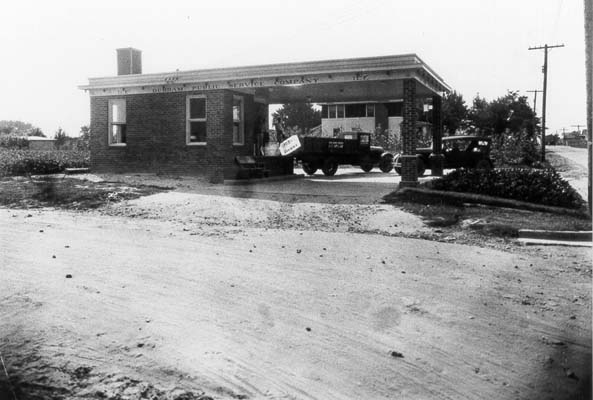
Hillsboro
Road in 1929 (Durham Public Service Co.)
In the old days, Hillandale Road was a narrow, unpaved dirt road which provided a place for stunts to be performed and witnessed. At one time, a two-man stunt team drove an old, probably a Dodge, touring car. The car would start at the top of the hill on Hillandale Road at its intersection with Hillsborough Road. One of the men would be driving and the other man would be standing blindfolded on the car's running board next to the side of the road and in a crouched position.
At some critical time, indicated by the driver with a flourish and related to the relatively slow speed and loud noise of the car, the blindfolded stunt man would jump off the car, tumble in the dirt and then would remove his blindfold, stand and bow to the crowd with great applause. A passing of a hat and collection of donations would follow. I remember trying to figure out how this could all happen repeatedly with no apparent injury to the stunt man.
The Circus Comes to Town
The old circus ground used to be at a Hillsborough Road location now occupied by a Kroger Store and a shopping center. The Ringling Brothers Barnum and Bailey circus would unload its rail cars opposite the East Duke Campus and would march the animals and circus vehicles to the circus ground. One day it was particularly hot when the circus arrived and word went out that with the animals being thirsty, a free ticket would be given to anyone who showed up with an empty washtub at the fire hydrant located at the intersection of Hillandale and Hillsborough Road. Needless to say, the tubs arrived, the animals got watered and many children in the community enjoyed a free circus matinee.
E.K. Powe School
Memories of E.K. Powe School recall a practice of requiring all the students to listen to an approximately one-hour radio program of music called, as I recall, the "Walter Damrosch Hour." It was here that we learned about sharps, flats, musical terms and musical instruments all of which has lasted through the years. I remember always looking forward to this wonderful hour and learning about some of the mysteries of music.
Fire Chief Frank Bennett visited E.K. Powe and sang songs which caught our attention and effectively taught us the dangers of oily rags and how a magnifying glass could start a fire. Even today, I find myself very sensitive to fire hazards.
Epilogue
Old West Durham lives on. With the recited experiences in old West Durham as a start in life, the writer, Billy B. Olive, went on to become a graduate of both Duke University in Electrical Engineering and Saint Johns University in Law and today at about eighty-years of age, still practices on a part-time schedule as a Patent Attorney in the Intellectual Property Law Firm of Olive & Olive, P.A. in Durham.
10,000 People See Two Performances of Circus (Durham Morning Herald. 4 September 1951)
The audience saw Tom Paris, the only gymnast ever to accomplish a triple forward somersault; the incomparable del Morals, high perch pole artists; Senor Manuel Barrigan of the Argentine, who apparently provided more thrills than any other performer with his aerial act high in the dome of the tent; Senor Olvera, 'incredible human gyro' who swung dangerously on a trapeze while balanced on his head; Maximilliano Truzzi, the greatest juggler since Rastelli; the world renowned Cristiani Family with Lucio, the greatest riding comedian of all time; and Hugo Zacchini, the mild-mannered 'human cannonball' who loves to paint landscapes with political meaning. The circus also boasts several side shows, and a menagerie composed of elephants, a giraffe, assorted cats, at least two hyenas, baboons, and other wild beasts.
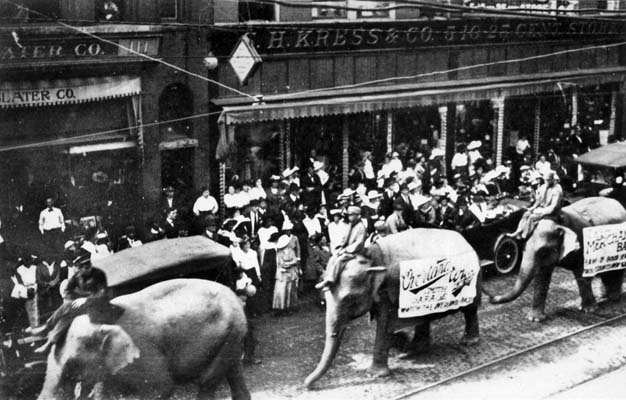
Elephant
parade up Main Street (ca. 1920): sidewalk filled with people watching
elephants draped with signs of local businesses.
Other headlines: "Council Expected To Take Action on Proposal for Fluoride Vote," "Home Building and Loan Association Structure Will Be Dedicated Today," and "Mud Hole Blocks Local Boys Ride in Stolen Truck."
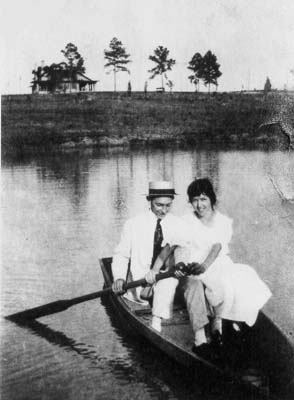
Engaged couple Beatrice & Graham Maynard enjoy an outing on Durham Reservoir by Hillandale Road in 1916.
"Each Christmas my family enjoyed seeing the city reservoir at the end of West Club Boulevard. Members of the Durham Fire Department constructed a huge tree made of strings of colored lights over the water. I never understood how they accomplished this feat. During the 1970s when my grandchild was growing up near the reservoir, one of her little friends asked her father what the precious little building in the reservoir was. He said it was Santa Claus' summer home. It still stands there." -Edna Baker
B&W photographs courtesy of the Durham County Library's North Carolina Collection
Mashed Potato Candy
(Depression-era candy made in some West Durham kitchens)
* One-half cup of leftover mashed potatoes (not instant)
* 1 teaspoon vanilla extract
* 28 ounces powdered sugar (1.75 sixteen-ounce boxes)
* Smooth peanut butter
In a mixing bowl, combine the leftover mashed potatoes, the vanilla and one cup of powdered sugar. Set the remaining powdered sugar (about 20 ounces) aside.
Stir until the sugar is dissolved and the mixture becomes a thin syrup. Continue adding powdered sugar into the mix, while stirring thoroughly. As the remaining sugar is added, the mixture will become very stiff and difficult to stir.
Remove mixture from bowl and place on a sheet of waxed paper that is coated with powdered sugar. Dust a rolling pin with powdered sugar and roll out the mixture like a pizza crust (about 18 inches in diameter).
Using a spatula, spread a generous amount of peanut butter on the mashed potato candy and curl it up tightly, like a jellyroll. Wrap candy in waxed paper, and refrigerate for three or four hours. Cut into half-inch slices and serve.

